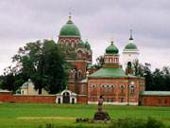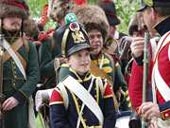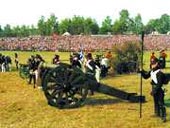In order to send a request or get more detailed information please contact travel@r-tg.com or fill in the booking forms below:
Tours Order Form
Hotel Order Form
Transfer Order Form
Tickets Order Form
or call us at our toll free number 1-866-387-5141.
Borodino Borodino site of the most famous battle in the War of 1812 is 120 kilometers (74 miles) southwest of Moscow. In the late spring of 1812, Napoleon led his massive army of more than half a mill ion men into Russia. Presented with no other option but a bloodbath, the generals of Alexander I’s armies ordered a humiliating retreat. But, in August, the czar appointed 67 – year – old Prince Mikhail Kutuzov as commander – in – chief to stop Napoleon invading Moscow. On August 26 1812, the Russians took on the French at Borodino. Napoleon’s army numbered over 135,000 soldiers with 600 guns. Remarkably, after 15 hours of fighting (and 75,000 dead from both sides), Napoleon was forced to retreat; the Battle of Borodino marked the tuning point of the war. Kutuzov’s generals, including Barclay de Tolly, wanted to stage another battle with Napoleon before Moscow, but Kutuzov wanted to save his armies from yet another bloody encounter. He argued, “Moscow will be the sponge that will suck him in”. Meeting no resistance, Napoleon’s remaining troops entered the gates of Moscow on September 2 at Poklonnaya Gora (Hill of Greeting) and waited for a formal surrender. No one arrived and the French found Moscow nearly deserted. As Napoleon slowly marched towards the Kremlin, immense fires broke out throughout the city; eventually over 80 percent of Moscow would burn to the ground. By mid – October, with winter approaching and no supplies at hand, Napoleon was forced to abandon Moscow and undertake a long march home during one of the worst winters on record. When he finally released his army only 25,000 Frenchmen remained alive. To celebrate Russia’s triumphant victory, Alexander I ordered the Cathedral of Christ the Savior built in Moscow “in the name fatherland to express our thanks and gratitude to all our loyal subjects, true sons of Russia”. ion men into Russia. Presented with no other option but a bloodbath, the generals of Alexander I’s armies ordered a humiliating retreat. But, in August, the czar appointed 67 – year – old Prince Mikhail Kutuzov as commander – in – chief to stop Napoleon invading Moscow. On August 26 1812, the Russians took on the French at Borodino. Napoleon’s army numbered over 135,000 soldiers with 600 guns. Remarkably, after 15 hours of fighting (and 75,000 dead from both sides), Napoleon was forced to retreat; the Battle of Borodino marked the tuning point of the war. Kutuzov’s generals, including Barclay de Tolly, wanted to stage another battle with Napoleon before Moscow, but Kutuzov wanted to save his armies from yet another bloody encounter. He argued, “Moscow will be the sponge that will suck him in”. Meeting no resistance, Napoleon’s remaining troops entered the gates of Moscow on September 2 at Poklonnaya Gora (Hill of Greeting) and waited for a formal surrender. No one arrived and the French found Moscow nearly deserted. As Napoleon slowly marched towards the Kremlin, immense fires broke out throughout the city; eventually over 80 percent of Moscow would burn to the ground. By mid – October, with winter approaching and no supplies at hand, Napoleon was forced to abandon Moscow and undertake a long march home during one of the worst winters on record. When he finally released his army only 25,000 Frenchmen remained alive. To celebrate Russia’s triumphant victory, Alexander I ordered the Cathedral of Christ the Savior built in Moscow “in the name fatherland to express our thanks and gratitude to all our loyal subjects, true sons of Russia”.
In 1912, to mark the battle’s 100th anniversary, 34 monuments were erected throughout the battlefield. The polished granite obelisk (1966) crowned by a bronze eagle is dedicated to Field Marsha

l Kutuzov. Leo Tolstoy visited the battlefield in 1876 while writing War and Peace. Other memorials commemorate World War ll battles that took place here in 1941.
Every year the anniversary of the 1812 battle is celebrated by a Borodino Field Day, when the battle is actually reenacted. People playing the French and Russian soldiers dress in period uniforms, cannons roar and smoke rises from the battlefield. A religious ceremony is held after the battle to give thanks for Napoleon’s defeat.
Filmmaker Sergei Bondarchuk’s four – part nine – hour epic War and Peace was Russia’s longest and most expensive film ever made. Taking five years to produce, it encompassed some of the most spectacular battle scenes ever seen on film. During the recreated Battle of Borodino over 120,000 extras were used from the Soviet army.
If you have time for a local side – trip while in Borodino, visit the Spaso – Borodinsky (Borodino`s Savior) Convent in the Village of Tuchkovo. It was established by Margarita Tuchkova, widow of the famous General Alexander Tuchkov, who died in Borodino defending positions against the French. In 1820, Alexander I donated 10,000 rubles for Margarita (she was of the noble Naryshkin family ) to construct a church in honor of her husband and those who fell in battle. Inside the church is a marble cross inscribed with the words, “Remember, O Lord, in Thy Kingdom, Alexander, killed in battle”. Later, Margarita moved to Borodino from Moscow and became a nun in 1840. Czar Nicholas I made further donations to the site and was present at the convent’s consecration. Up until her death in 1852, Margarita (now Mother Superior Maria) provided shelter to homeless, abused and elderly women. Until 1917 it was the model for all other convents across the country. In a twist of fate, when the Nazis invaded during WWII the buildings were used as a concentration camp. In the 1990s, the convent underwent massive renovation work and today the churches and refectory (with its splendid iconostasis) are open to the public. The convent was renown for its beautifully sewn icons, where the women embroidered on silk, satin and velvet, with gold and silver threads. ) to construct a church in honor of her husband and those who fell in battle. Inside the church is a marble cross inscribed with the words, “Remember, O Lord, in Thy Kingdom, Alexander, killed in battle”. Later, Margarita moved to Borodino from Moscow and became a nun in 1840. Czar Nicholas I made further donations to the site and was present at the convent’s consecration. Up until her death in 1852, Margarita (now Mother Superior Maria) provided shelter to homeless, abused and elderly women. Until 1917 it was the model for all other convents across the country. In a twist of fate, when the Nazis invaded during WWII the buildings were used as a concentration camp. In the 1990s, the convent underwent massive renovation work and today the churches and refectory (with its splendid iconostasis) are open to the public. The convent was renown for its beautifully sewn icons, where the women embroidered on silk, satin and velvet, with gold and silver threads.
|

